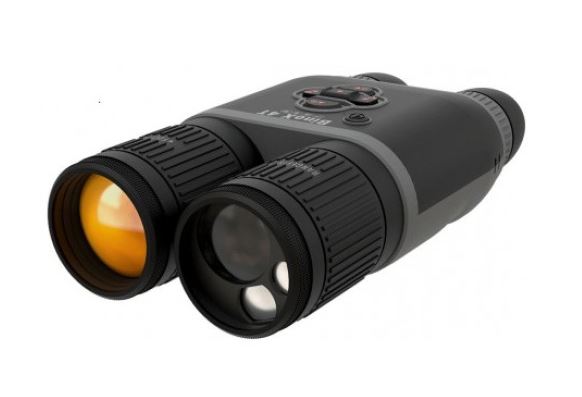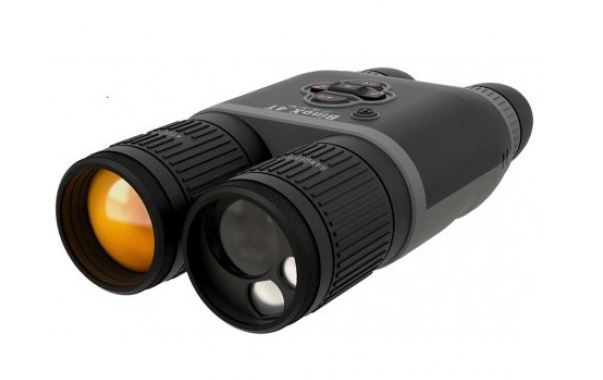Product: Minox DTC 395 Trail Camera
Introduction
Congratulations on the purchase of your MINOX DTC 395 wildlife camera.
Like all other MINOX products, this wildlife camera boasts the traditional values fostered by MINOX. It combines functionality in the smallest possible space with the best optical quality. Simple and fast operation makes the MINOX DTC 395 ideal for digital photography and videos in the intended field of use.
These instructions are to help you take advantage of the nfull range of performance that your MINOX DTC 395 wildlife camera has to offer.
Note
- We have done our best to produce a complete and accurate manual. However, we cannot ensure that there are no errors or omissions during the printing process.
- We cannot take responsibility for any damages caused by unauthorized attempts to upgrade software or for any data corruption while the product is being repaired.
- Please Back Up Your Files! We cannot be held liable for the loss of data caused by damaged products or damage due to unreadable memory cards or drives.
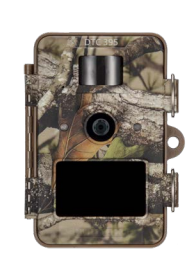
Contents
1. Safety instructions
2. Get to know your MINOX DTC 395
3. Elements and controls
4. Preparing the camera for use
– Explanation of the controls
– Inserting the batteries
– Checking the battery level
– Inserting the memory card
– Language setting
– Mounting the camera
5. SETUP mode
6. Operating the camera
7. Image playback
8. Connecting the camera to a computer
9. Further information
– Storage
– Disposal
– Legal information
– Declaration of conformity
– MPEG-4 Visual Patent Portfolio License
– Technical data
– Warranty terms
1. Safety instructions
If the camera and accessories are not handled correctly, there is a risk to you and others, or the camera may be damaged or destroyed. Please carefully read and adhere to the following safety instructions.
Intended use
– This camera is intended to record images and videos on your own private property or with the explicit permission of property owners. It is intended for private use only and not for commercial purposes.
Hazards for children and persons with limited abilities when operating electronic devices
– The camera, accessories and packaging are not toys and should be kept out of the hands of children. There is a risk of electric shock, poisoning and suffocation.
The camera and its accessories should not be used by children or persons with limited abilities. The camera may only be used by persons who are physically and mentally capable of using them safely
Electrical hazards
- If foreign bodies or liquids have entered the camera, turn it off and remove the batteries. Allow the camera to dry thoroughly as there is a risk of fire or electric shock.
- If the camera has dropped or the housing is damaged, turn the camera off and remove the batteries. There may be a risk of fire or electric shock.
- The camera may not be disassembled, modified or repaired by unqualified persons. There may be a risk of fire or electric shock.
- Only use a 6 V mains adapter (not included in the scope of delivery) to power the camera externally, otherwise there is a risk of fire or electric shock. Disconnect the power supply by removing the mains adapter from the socket. If the mains adapter (not included in the scope of delivery) remains in the wall socket, it can still consume power and represent a source of danger.
- In the event of a thunderstorm, the mains adapter (not included in the scope of delivery) should not be used. There is a risk of electric shock.
Heat damage – risk of fire
- Do not leave the camera in places where the temperature can rise sharply (e.g. in a vehicle). This could damage the housing and internal parts, which in turn can cause a fire.
- Do not wrap or place the camera on textiles as this could lead to a build-up of heat inside the camera. This can cause the housing to deform and increase the risk of fire.
Possible hazards when using batteries
- Replace all batteries at the same time. Clean the contacts on the batteries and inside the camera before inserting fresh batteries. Before disposal, the batteries must be removed from the camera and disposed of separately from the unit.
- Remove the batteries if the camera will not be used for a longer period of time. If the batteries have remained in the camera for an extended period of time, remove them immediately as they might overheat and thus increase the danger of fire when the camera has been activated.
- here is a risk of explosion if the batteries are incorrectly inserted or if the wrong types are used. Use only LR6 or NiMH 1.5 V AA batteries.
- Do not expose the batteries to excessive heat such as direct sunlight, open flames etc. as this may cause a fire or explosion. Do not store batteries near fire, ovens or other sources of excessive heat.
- Batteries should never be stored at temperatures below 10°C (50°F) and not above 40°C (104°F). Keep the batteries out of the reach of children.
- Never transport batteries in a bag or toolbox as they may come into contact with metal objects and thus raise the risk of fire.
- Batteries should never be thrown into a fire, short circuited, forcefully discharged, deformed or taken apart. This will greatly raise the risk of fire or explosion.
- Do not touch batteries that have leaked without proper protection. If battery acid has come into contact with your skin, thoroughly wash the area with plenty of soap and water.
- If you get battery acid in your eyes, rinse your eyes with plenty of water and contact a doctor immediately.
- Batteries should be disposed of exclusively at specifically designated collection points or at your retailer.
Possible injuries and property damage
WARNING! To avoid injuries, the camera must be securely mounted on the ground, on a tree, on a post or on a wall.
- Place the camera only on stable surfaces. Otherwise, the camera may fall or tilt; it can be damaged and cause injury.
- Do not use the camera while walking or driving. You could stumble or cause a traffic accident.
- Only use a 6 V mains adapter (not included in the scope of delivery) to power the camera externally. MINOX is not liable for damages caused by the use of a wrong mains adapter.
- The power socket used for the mains adapter (not included in the scope of delivery) must be free and accessible at all times so that the mains adapter can be quickly disconnected if necessary.
- Ensure adequate ventilation and do not cover the mains dapter (not included in the scope of delivery) to avoid overheating.
- Do not place open sources of fire such as burning candles on or near the camera.
- Do not expose the LCD display to impact or pressure. This can damage the glass of the display or cause the liquid to leak from the interior of the display. If the liquid gets into your eyes or on the skin, rinse immediately with clear water. If the fluid gets into the eyes, immediately get medical treatment.
- Damage to the electronics, the display or the lens caused by external influences such as inadvertent blows, dropping the camera or inappropriate handling are not covered by the warrantee and are therefore subject to charges.
- Do not let the camera fall and avoid hard knocks. Taking good care of your MINOX DTC 395 will provide you with many years of fault-free use.
Scope of delivery
– MINOX DTC 395 wildlife camera
– Mounting strap
– Wall mount
– USB cable
– Instruction manual
Note: The actual contents may vary from this list. The scope of delivery is subject to change without prior notice.
Note: Please format the SD memory card before use. Files on the card from other devices may affect the functionality of the camera.
Further information about accessories for the DTC 395 can be found on the MINOX website: www.minox.com.
2. Get to know your MINOX DTC 395
Please take a few moments to carefully read the following guidelines:
- 12 megapixel resolution (interpolated)
- Convenient 2.4” colour display
- Daylight images in colour, night images in black & white
- Fast trigger release (0.7 sec.)
- Invisible IR-flash with a range of
approx. 15 metres (16 yds.) - Low power consumption (Standby up to 6 months)
- SD memory card up to 32 GB
- Password protection
- Easy mounting by means of a separate bracket
- Splash-proof according to IP 54 specifications
3. Elements and controls
1. IR LEDs for night images
2. Twilight sensor
3. Clamps
4. Eyelet for padlock
5. Central motion sensor
6. Lens
7. Red LED
8. Microphone
9. Control buttons
10. Display
11. Battery compartment
12. ¼” tripod socket
13. 6V external power port
14. Main switch (OFF, SETUP, ON)
15. Mini-USB port
16. SD memory card slot
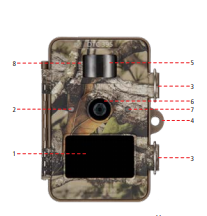
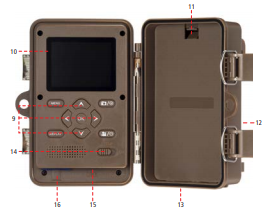
4. Preparing the camera for use
Explanation of the controls
To prepare your camera before use, proceed as follows:
1. Place your DTC 395 in front of you.
2. Open both clamps.
3. Open the camera to the left.
On the bottom left, you will see the control buttons. The switch for the three main functions can be found on the bottom of the left half of the camera:
1. “OFF” mode: Move main switch to left
2. “SETUP” mode: Move main switch to middle
3. “ON” mode: Move main switch to right
The SD memory card slot and USB port are also found on the bottom of the left half of the camera. At the upper left of the camera, you will find the 2.4” LCD display.To the right, you will see the battery compartment for eight 1.5 Volt AA batteries.
The port to connect a 6 V mains adapter can be seen on the outside of the housing, at the bottom left of the camera.
Inserting the batteries
Your DTC 395 camera is designed to be used with alkaline, lithium or nickel-metal hydride (NiMH) AA batteries. To insert the batteries, open the camera as described above. Remove the battery compartment cover by pulling the clip lock down. Insert eight 1.5 Volt AA batteries, making sure that the batteries are inserted to match the +/- poles. The camera can be operated with just 4 batteries, but then with less operating time. If you choose to use only 4 batteries, they can be inserted in either the upper or lower half of the battery compartment.
Note: An external 6V mains adapter can be used to power the camera. If the camera is attached to an external power source, the batteries will be bridged. This means that rechargeable batteries cannot be charged while in the camera, not even with a solar panel. Please do not use a mains adapter of more than 6 V as this will damage the camera, thus nullifying the warranty.
Checking the battery level
Switch your DTC 395 to “SETUP” mode (main switch at the centre). The battery status will be indicated at the bottom right of the display.
Note: We recommend using high efficiency batteries for optimum performance. You can prolong battery life if you create shorter video sequences.
Memory card
To record images or videos, you will need an SD/SDHC memory card. Your DTC 395 camera supports memory cards up to 32 GB.
Inserting the memory card
Open the camera housing and insert the memory card into the slot, making sure that the gold-coloured contacts are at the top and away from you when inserting the card. Ensure that the SD card is not write-protected (SD card slider is not in the “Lock” mode). Switch your DTC 395 to “SETUP” (main switch at the centre). If the SD card has been inserted improperly, is not inserted at all or is not compatible, you will see the corresponding message in the display. After inserting the proper card correctly, you can continue with setting your camera.
Note: If the SD card was used to store data in other devices, reformat the SD card on a PC. By reformatting the card, all previous data will be deleted to ensure error-free operation. If the SD card has only been used in the DTC 395, formatting can be done with camera as well. It is recommended to take some test photos to make sure that the SD card is functioning properly.
Language setting
The default language settings of your DTC 395 wildlife camera are in German. To change the language, please follow these steps:
1. Move the main switch to “SETUP”.
2. You will now be in the manual photo release mode.
3.Push the MENU button to enter the main menu of the camera.
4. Push the “down” arrow button until you reach “Sprache”.
5. Push OK.
6. Using the “up” and “down” buttons, choose your language.
7. Push OK.
8. The camera will now go back to the main menu.
Your camera is now set to the language of choice.
Mounting the camera
1. Mounting strap: The mounting bracket on the back of the camera can be used to mount the camera on a tree or post. The strap can be pulled through the bracket and around the tree or post and then tightened. Once the camera has been mounted, it can be turned 90° and removed from the bracket, and reattached in the same way. This enables a quick and easy removal of the camera to make necessary settings, exchange the batteries or remove the SD card, without having to reposition the camera afterwards.
2. Tripod: The ¼” socket at the bottom of the mounting bracket can be used to mount the camera on a tripod or the wall mounting bracket included in the scope of delivery.
3. Wall mount: The DTC 395 can be mounted on a wall or ceiling with the wall mount (included in the scope of delivery). Please make sure that the fastening screws are tight before attaching the camera.
5. SETUP mode
Set your DTC 395 camera to “SETUP” mode (move main switch to middle). The camera will automatically be set to “Manual operation” mode (in this mode, you can record test photos and videos). Press the menu button to access the main menu of the camera.
Here you can select various basic settings for camera operation. The factory default settings are shown in bold lettering in the following. You can simply ignore each menu item where you wish to retain the factory default setting.
a) Mode: Photo, video, photo+video, record photos and videos at fixed intervals. First select whether you want the camera to record photos or videos. In “Photo+video” mode, the camera will record a preselected number of photos and videos. If you select the option for recording photos or videos at specific intervals, the movement sensor will be automatically deactivated.
b) Photo quality: Here you can select from various photo resolution options. We recommended retaining the default setting 5M. You can select a higher resolution for better image quality, but the corresponding data will require more space on the memory card.
c) Video quality: Here you can select from various quality options. The default option is 1080 P (FHD). If you select a lower resolution, the details of the resultant video will be less sharp but less space will be required on the memory card.
d) Number of photos: 1, 2 or 3 photos. Select the number of photos to be recorded when the camera is triggered. See also “Interval setting”.
e) Video duration: 10 – 59 seconds or 1 minute. Select the duration of the video to be recorded when the camera is automatically triggered. The default setting is 10 seconds.
f) Interval setting: Select the time duration during which the camera should wait after being triggered before recording further photos or videos. This prevents unnecessary operation of the camera in situations in which, for example, an animal is unlikely to stay in front of the camera for long. The interval can be set in the range 5 seconds to 60 minutes. The default setting is 1 minute.
g) Time lapse: If you have selected the time lapse option for the recording of photos or videos per section a, you can define the time duration between the recording of images here. You can select a time duration in the range 5 seconds to 24 hours.
h) Shutter speed: We recommend 1/15 second to record high resolution images at night; however, there can be motion blurring at this setting. 1/20 second provides for moderate resolution images at night and less motion blurring. 1/30 second provides less resolution at night but also the lowest level of motion blurring in daylight. Please select the setting that is most appropriate for your intended use.
i) Time stamp: On/Off. Select “On” if you wish the date, time, temperature and phase of the moon to be shown in your recorded images – otherwise select “Off”.
j) Timer setting: On/Off. If you want the camera to be operational only during a certain period during each day, you can select the appropriate time here. Set to “On” to select the timer start and end time. Outside your selected time period, the camera will not record photos or videos.
k) Password: On/Off. Select “On” if you wish to enter a four-character password to prevent unauthorised use of your camera. Please note that you will then have to enter your password each time you switch on the camera. Important: If you forget your password, you can activate the camera using the password “OPEN”.
l) Serial number: Here you can enter a four-character serial number or name that will be shown in your images. If you are using several cameras simultaneously, you will then be able to see which of your cameras has recorded a particular image.
m) Flash: Auto/High/Low. Set here the required intensity of the LED flash.
n) Audio recording: On/Off. Select here whether you wish audio sounds to be also recording during video mode.
o) Automatic switch-off in “SETUP” mode: 3 minutes, 5 minutes, 10 minutes, Off. Select the time period after which the camera is to be automatically deactivated while in “SETUP” mode.
p) Illumination duration: 1 minute, 3 minutes, 5 minutes, Off. The LCD monitor will be automatically deactivated after the selected time.
q) Date/time settings: Set the date and time here.
r) Reformat the memory card: Yes, No. If you select “Yes” and then press the “OK” button to confirm, all the data on the memory card will be deleted. This is a useful option if you are using memory cards that have also already been used in other devices.
s) Language: Select here the language for your camera settings.
t) Factory default settings: Yes, No. Select “Yes” to reset thecamera to the original factory default settings (these are shown here in bold lettering).
u) System: There are two options under this menu item. Select “FW update” to download new firmware updates to your camera. Confirm you wish to do this by pressing the “OK” button. Select “FW version” to see which firmware version you are using in your camera.
In “Playback” mode, you will have the option of deleting selected photos or videos from the memory card.
6. Operating the camera
Switch your DTC 395 to “ON” mode (main switch to the right). In this mode, your DTC 395 will automatically use the most previous settings made while in the Settings Mode.
Note: The red activation LED will blink several seconds before the camera enters operational mode. When the LED stops blinking, the camera is ready to record images and videos in accordance with your settings.
Night mode:
For night-shots, the necessary lighting is provided by the infrared LEDs on the front of the camera. The maximum recording distance in the dark is about 10 meters (33 feet).
Due to the nature of the infrared lighting, night-shots are in black and white.
Aligning the camera:
The wide angle of the camera lens makes aligning your camera quite simple: a rough eye alignment is enough at first. Then pay particular attention to the vertical tilt, i.e. the correct inclination of the camera. This is especially important when the camera is not mounted on straight, vertical posts or surfaces. Once you have found a good position, switch the camera to SETUP mode.
Move from one side to the other in front of the camera. The red LED should flash to show that you have been detected by the motion sensor. This should help you decide roughly where to direct the camera lens. Such a general orientation is usually sufficient.
Note: The coloured LEDs light up only when in TEST mode. When the main switch has been moved to ON, the LEDs do not light up anymore.
If you wish to fine-tune the alignment of your camera, set the camera to ON mode (main switch to the left) and enter the camera’s field of view from different directions. Then carefully turn the camera 90° and remove it from the mounting bracket. Go to TEST mode and push the REPLAY button to view your results. If necessary, you can correct the alignment and repeat the procedure. If the alignment of the camera is to your satisfaction, the camera can be switched to ON.
Note: To avoid undesired images or videos, do not set the camera up in sunny areas. Make sure that branches do notmove in front of the camera. The MINOX DTC 395 is dustproof and splashproof and fulfils the IP 54 protection classification. It is suitable for outdoor use in all weather conditions.
7. Image playback
Once your camera has recorded images, you can view these using the “Playback” option. You will first need to set the camera to “SETUP” mode. Now press the “Replay” button and you‘ll be able to view the photos and videos that your camera has recorded. You can browse through these using the arrow buttons. Press the “OK” button to start and stop playback of videos.
Press the “Menu” button during “Playback” mode if you wish to delete selected photos or videos. You also have the option of deleting all recorded photos and videos at once. For safeguarding purposes, it will be necessary for you to select these options again before they become effective. Press the “Replay” button to stop playback.
8. Connecting the camera to a computer
Your MINOX DTC 395 saves your photos and videos in a folder named “DCIM/100Media” on your SD card. Photos have the file ending “.jpg” and videos “.avi”. There are two possibilities to transfer the files to your PC: either you remove the SD card and insert it into a card reader or you connect the DTC 395 to your PC with the USB cable included in the scope of delivery.
Transferring your files via USB cable
Always ensure that the camera is switched off before connecting it to a computer. Connect your camera to the computer using the USB cable (included in the scope of delivery) via the USB port. Switch the camera to TEST mode (main switch in the middle). The camera will now be recognized as a removable storage device. Your photos and videos can now be copied to a folder on your PC.
Transferring your files via SD card
Always ensure that the camera is switched off before the SD card is removed from the camera, otherwise the files on your memory card could be damaged. Remove the memory card from the slot and insert it into the card reader connected to your computer. Some computers also have an internal slot for SD cards – in this case, insert the SD card directly into the slot on your computer. Your photos and videos can now be copied to a folder on your PC.
Connection to the TV
To connect to the TV, set the MINOX DTC 395 to SETUP mode and then connect the USB cable to the camera. Connect the other end of the cable to the TV. Then select the appropriate video input source on the TV set for the USB input you are using.
9. Further information
Storage
If you will not be using your MINOX DTC 395 for an extended period of time, remove the batteries and store the camera in a cool and dry place.
Disposal
The packaging should be disposed of in a clean and environmentally safe manner. Batteries must not be disposed of in the household waste. The consumer is legally obliged to return dead batteries at designated collection points or at the retailer where the batteries were purchased.
Correct disposal of this product
This symbol indicates that within the EU, electronic devices are not allowed to be disposed of in the household waste. Please use the designated collection points for the recycling of electrical and electronic equipment in your community or ask your dealer where your device can be properly disposed of. This prevents possible harmful effects on the environment and health through improper disposal. Further information can be obtained from municipal services near you.
Legal information
The use of the MINOX DTC 395 is subject to a wide range of legal regulations which can vary from country to country, especially for recording images in public spaces. Please observe the national legislation for the protection of personal rights. It is especially important not to make photos or videos of persons in public places.
The use of the MINOX DTC 395 in forests and fields can be subject to other regulations. For example, the use of wildlife cameras in Germany is regulated by the National Hunting Legislation. Please also note the applicable legislation in your particular country and/or district.
Declaration of conformity
The manufacturer hereby declares that this CE marking has been affixed to this device in accordance with the essential requirements and other relevant provisions of the following European Directives:
– 2011/65/EG RoHs Directive
– 2014/30/EN EMV Directive
The EC declaration of conformity can be obtained from the address provided at the end of this manual.
MPEG-4 Visual Patent Portfolio License
This MINOX DTC 395 is licensed under the MPEG-4 Visual Patent Portfolio License for personal and non-commercial purposes to:
1. encode video files in compliance with the MPEG-4 standard and/or
2. decode MPEG-4 video files that was encoded by a consumer engaged in a personal and non-commercial activity and/or was obtained from a video provider licensed to provide MPEG-4 video. For other purposes, no license is granted or implied for the MPEG-4 standard.
Further information can be obtained from MPEG LA, LLC on http://www.mpegla.com
Technical data
| Resolutin (adjustable) | 12 MP (interpolated),
8 MP (interpolated), 5 MP (interpolated) |
| Trigger release | 0,7 sec. |
| Photo burst | 1 – 3 photos per release (adjustable) |
| Video resolution | 1920×1080 (30fps), 1280×720 HD (30fps); 848×480 (30fps); 640×480 VGA (30fps) |
| Video lenght (adjustable) | 10 – 59 sec., 1 min. |
| High power IR flash Range | approx. 15 m (16yds.) |
| Display | 2.4″TFT colour display |
| Daylight images | Colour |
| Night images | Black & white |
| User – friendly interface | 8 button control panel |
| Real – time display | Photo / video playback |
| Settings | Date, time, temperature and moon phase on each image |
| External memory | SD/SDHC card: up to 32 GB |
| Ports | USB port, 6 V port for an external power supply (min. 2000 mA) |
| Cable | USB cable (included in scope of delivery) |
| Batteries | Eight 1.5 V AA batteries alkaline, lithium-ion or NiMH |
| Password protection | 4 digit combination |
| Mounting aids | Mounting strap and wall mount (included in scope of delivery) |
| Dimensions (H x W x D) | 135 x 101 x 73 mm |
| Weight (without batteries) | 280 g (10 oz.) |
| Order no. | 80405444 |
Warranty terms
With the purchase of this MINOX DTC 395 you have acquired a product which has been manufactured and tested according to very high quality standards. The statutory warranty of 2 years provided for this product commences on the date of purchase from an authorized dealer and is subject to the following conditions:
1) During the warranty period, complaints based on faulty manufacture will be compensated free of charge either by repair, replacement of defective parts or replacement by an identical flawless product at our own discretion. Any further claims of any kind whatsoever, and irrespective of the legal basis in connection with this warranty, are excluded.
2) Claims under warranty are null and void if the defect has been caused by improper handling (which also includes the use of accessories made by other companies), if the product is serviced by unauthorized persons or workshops, or if the serial number has been obliterated.
3) Warranty claims can only be made by submission of an electronically printed sales slip from an authorized dealer.
4) When submitting claims under warranty, please return the MINOX camera together with the electronically printed sales slip, and a description of the complaint to the MINOX GmbH Customer Service or an international MINOX agency.
5) Tourists may, if required, make use of the MINOX agency in the country in which they are traveling. In accordance with the MINOX GmbH warranty terms, the electronically printed sales slip must nevertheless be presented.
MINOX GmbH
Walter-Zapp-Str. 4
D-35578 Wetzlar
Tel.: +49(0)6441/917-0
Fax: +49(0)6441/917-612
E-Mail: [email protected]
Internet: www.minox.com
